Strategic Management Accounting: Case Study and Analysis Report
VerifiedAdded on 2020/10/22
|9
|2163
|474
Report
AI Summary
This report focuses on strategic management accounting, exploring key concepts through case studies and financial analysis. It begins with an introduction to strategic management accounting and evaluates various case scenarios to enhance understanding of several accounting concepts. The report develops budgets, including fixed, flexible, and actual budgets, to determine variances for direct material and direct labor. It then analyzes different transfer pricing methods, comparing their advantages and disadvantages. The report examines accounting techniques such as balance scorecards and benchmarking and their suitable formats for the given scenario. The report also includes a columnar statement, subdivision of labor and material variances, and identification of potential causes of material and labor variances. The report concludes with the application of these concepts to a business solution company, CD Limited, and recommends improvements using benchmarking techniques.
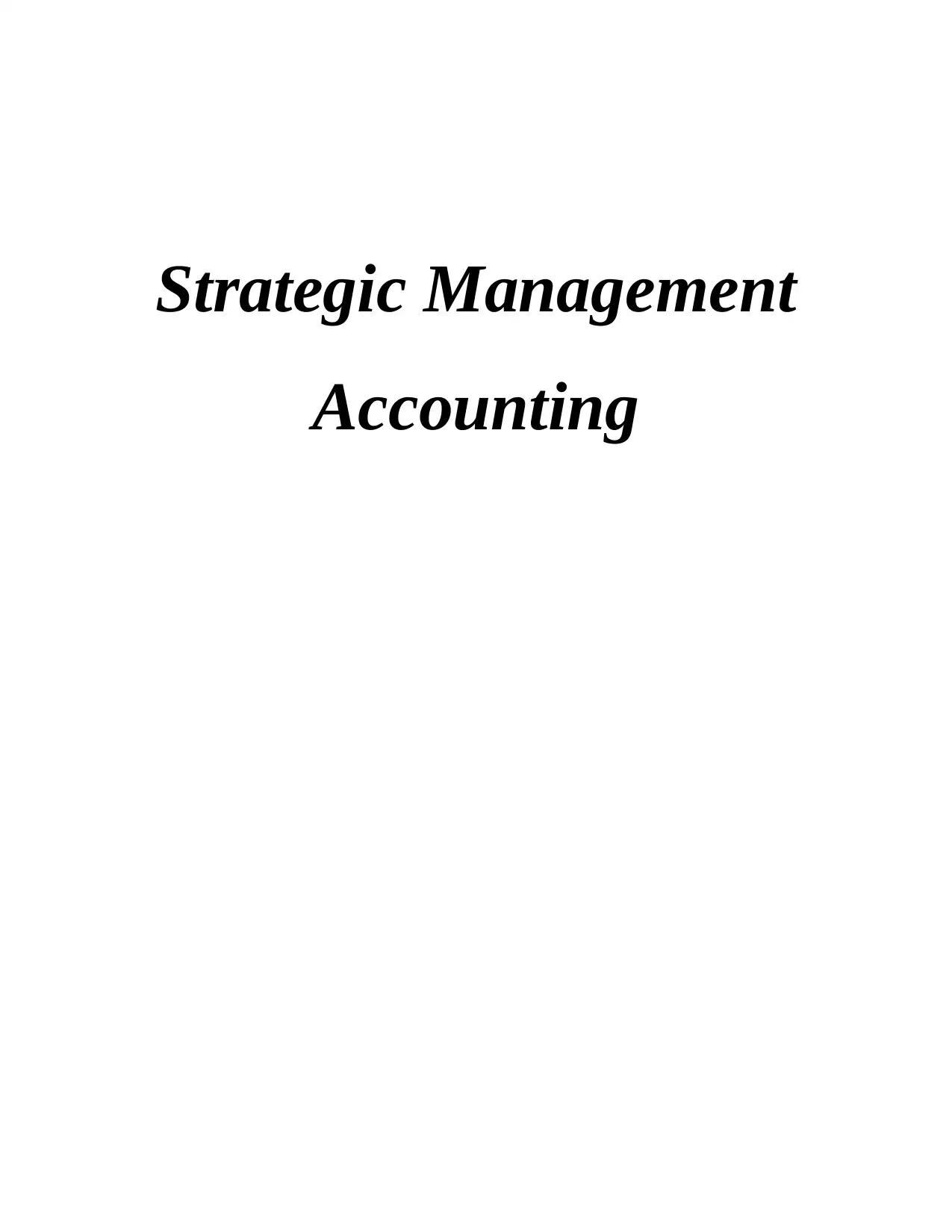
Strategic Management
Accounting
Accounting
Paraphrase This Document
Need a fresh take? Get an instant paraphrase of this document with our AI Paraphraser
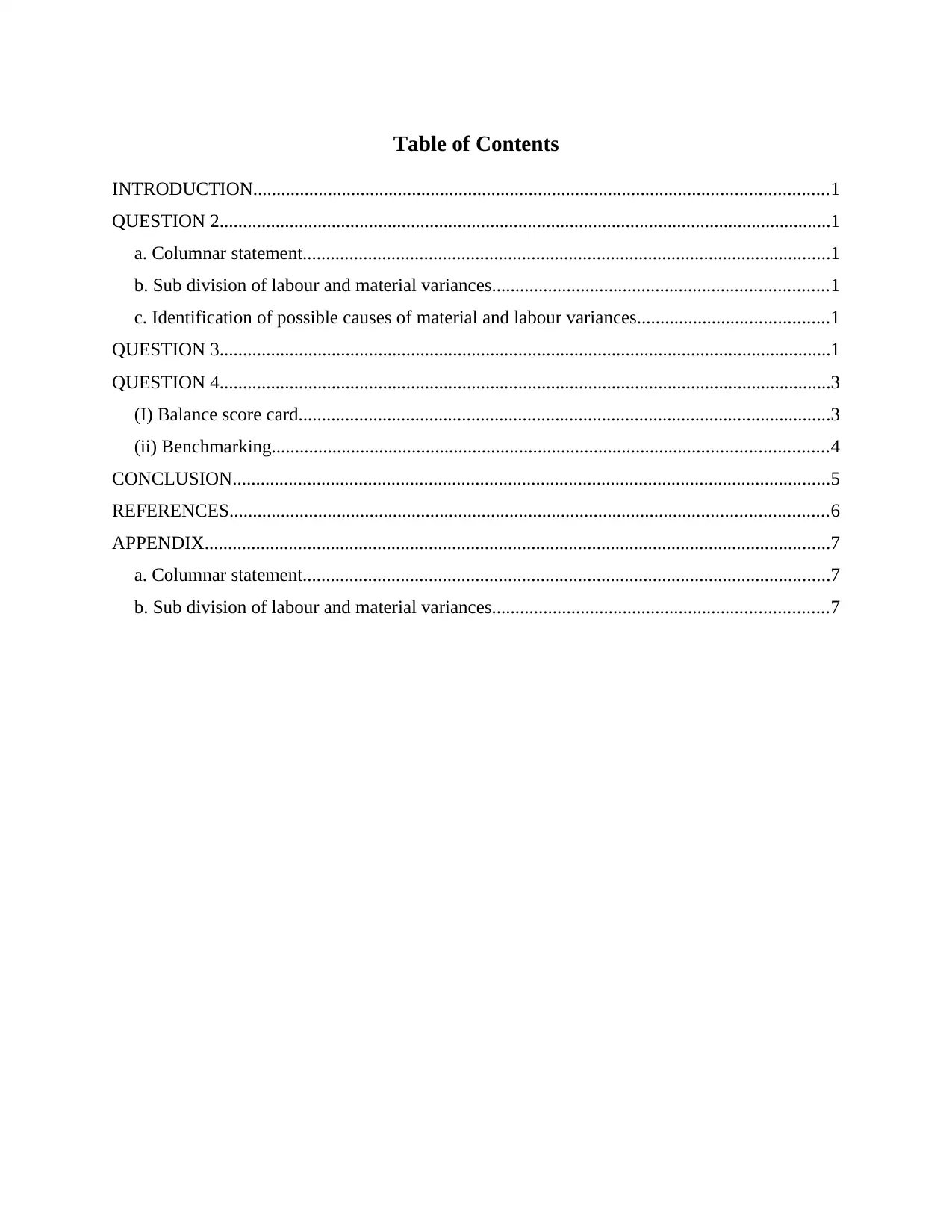
Table of Contents
INTRODUCTION...........................................................................................................................1
QUESTION 2...................................................................................................................................1
a. Columnar statement.................................................................................................................1
b. Sub division of labour and material variances........................................................................1
c. Identification of possible causes of material and labour variances.........................................1
QUESTION 3...................................................................................................................................1
QUESTION 4...................................................................................................................................3
(I) Balance score card..................................................................................................................3
(ii) Benchmarking.......................................................................................................................4
CONCLUSION................................................................................................................................5
REFERENCES................................................................................................................................6
APPENDIX......................................................................................................................................7
a. Columnar statement.................................................................................................................7
b. Sub division of labour and material variances........................................................................7
INTRODUCTION...........................................................................................................................1
QUESTION 2...................................................................................................................................1
a. Columnar statement.................................................................................................................1
b. Sub division of labour and material variances........................................................................1
c. Identification of possible causes of material and labour variances.........................................1
QUESTION 3...................................................................................................................................1
QUESTION 4...................................................................................................................................3
(I) Balance score card..................................................................................................................3
(ii) Benchmarking.......................................................................................................................4
CONCLUSION................................................................................................................................5
REFERENCES................................................................................................................................6
APPENDIX......................................................................................................................................7
a. Columnar statement.................................................................................................................7
b. Sub division of labour and material variances........................................................................7
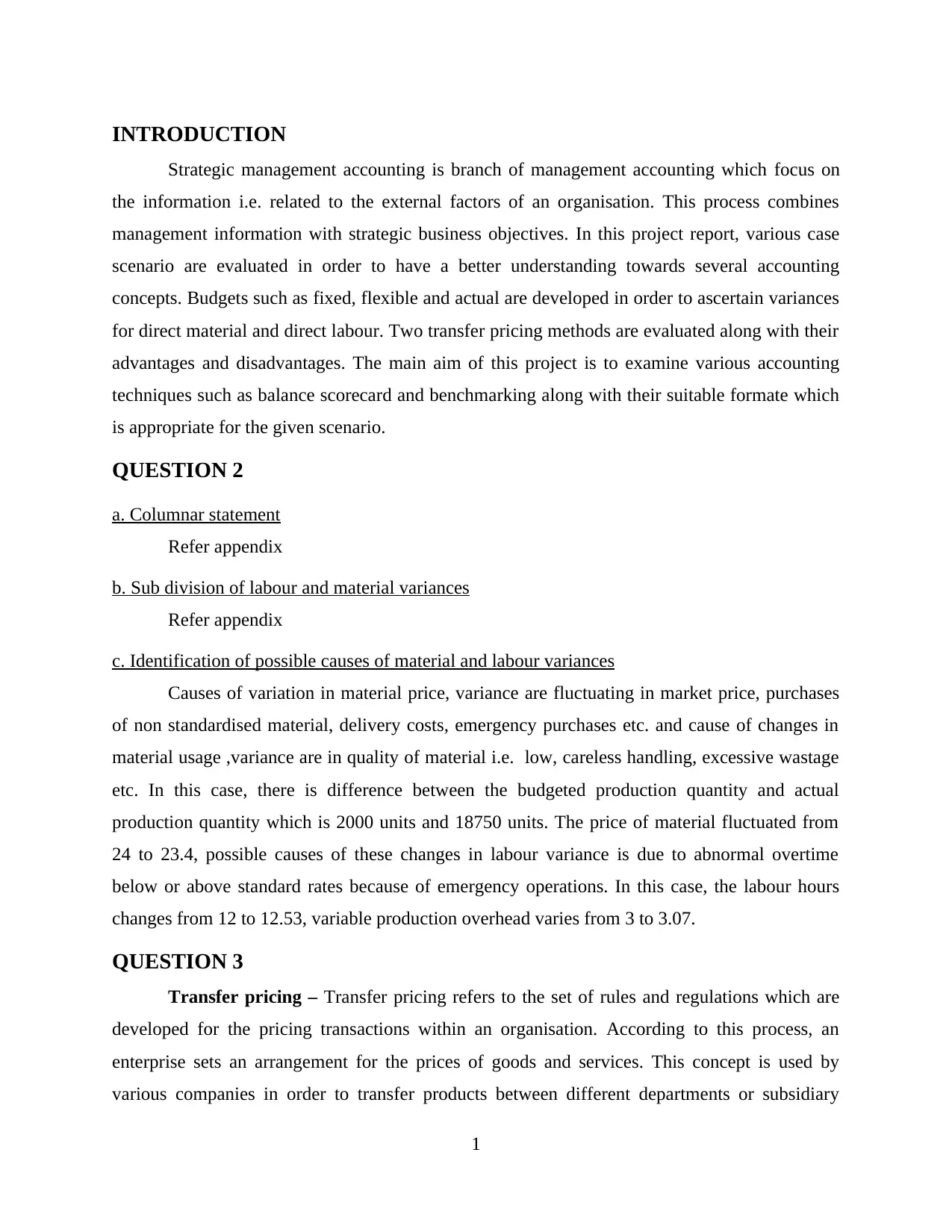
INTRODUCTION
Strategic management accounting is branch of management accounting which focus on
the information i.e. related to the external factors of an organisation. This process combines
management information with strategic business objectives. In this project report, various case
scenario are evaluated in order to have a better understanding towards several accounting
concepts. Budgets such as fixed, flexible and actual are developed in order to ascertain variances
for direct material and direct labour. Two transfer pricing methods are evaluated along with their
advantages and disadvantages. The main aim of this project is to examine various accounting
techniques such as balance scorecard and benchmarking along with their suitable formate which
is appropriate for the given scenario.
QUESTION 2
a. Columnar statement
Refer appendix
b. Sub division of labour and material variances
Refer appendix
c. Identification of possible causes of material and labour variances
Causes of variation in material price, variance are fluctuating in market price, purchases
of non standardised material, delivery costs, emergency purchases etc. and cause of changes in
material usage ,variance are in quality of material i.e. low, careless handling, excessive wastage
etc. In this case, there is difference between the budgeted production quantity and actual
production quantity which is 2000 units and 18750 units. The price of material fluctuated from
24 to 23.4, possible causes of these changes in labour variance is due to abnormal overtime
below or above standard rates because of emergency operations. In this case, the labour hours
changes from 12 to 12.53, variable production overhead varies from 3 to 3.07.
QUESTION 3
Transfer pricing – Transfer pricing refers to the set of rules and regulations which are
developed for the pricing transactions within an organisation. According to this process, an
enterprise sets an arrangement for the prices of goods and services. This concept is used by
various companies in order to transfer products between different departments or subsidiary
1
Strategic management accounting is branch of management accounting which focus on
the information i.e. related to the external factors of an organisation. This process combines
management information with strategic business objectives. In this project report, various case
scenario are evaluated in order to have a better understanding towards several accounting
concepts. Budgets such as fixed, flexible and actual are developed in order to ascertain variances
for direct material and direct labour. Two transfer pricing methods are evaluated along with their
advantages and disadvantages. The main aim of this project is to examine various accounting
techniques such as balance scorecard and benchmarking along with their suitable formate which
is appropriate for the given scenario.
QUESTION 2
a. Columnar statement
Refer appendix
b. Sub division of labour and material variances
Refer appendix
c. Identification of possible causes of material and labour variances
Causes of variation in material price, variance are fluctuating in market price, purchases
of non standardised material, delivery costs, emergency purchases etc. and cause of changes in
material usage ,variance are in quality of material i.e. low, careless handling, excessive wastage
etc. In this case, there is difference between the budgeted production quantity and actual
production quantity which is 2000 units and 18750 units. The price of material fluctuated from
24 to 23.4, possible causes of these changes in labour variance is due to abnormal overtime
below or above standard rates because of emergency operations. In this case, the labour hours
changes from 12 to 12.53, variable production overhead varies from 3 to 3.07.
QUESTION 3
Transfer pricing – Transfer pricing refers to the set of rules and regulations which are
developed for the pricing transactions within an organisation. According to this process, an
enterprise sets an arrangement for the prices of goods and services. This concept is used by
various companies in order to transfer products between different departments or subsidiary
1
⊘ This is a preview!⊘
Do you want full access?
Subscribe today to unlock all pages.

Trusted by 1+ million students worldwide
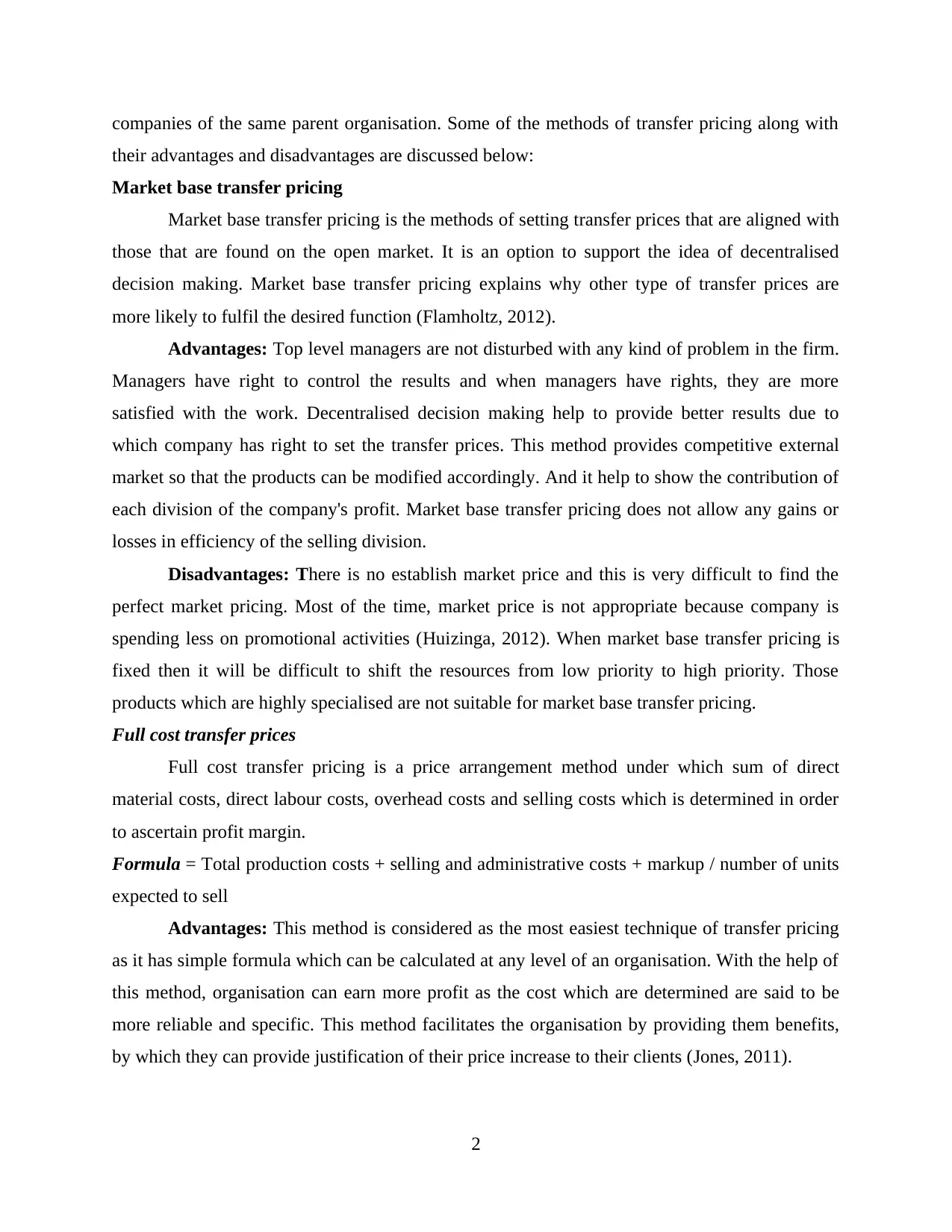
companies of the same parent organisation. Some of the methods of transfer pricing along with
their advantages and disadvantages are discussed below:
Market base transfer pricing
Market base transfer pricing is the methods of setting transfer prices that are aligned with
those that are found on the open market. It is an option to support the idea of decentralised
decision making. Market base transfer pricing explains why other type of transfer prices are
more likely to fulfil the desired function (Flamholtz, 2012).
Advantages: Top level managers are not disturbed with any kind of problem in the firm.
Managers have right to control the results and when managers have rights, they are more
satisfied with the work. Decentralised decision making help to provide better results due to
which company has right to set the transfer prices. This method provides competitive external
market so that the products can be modified accordingly. And it help to show the contribution of
each division of the company's profit. Market base transfer pricing does not allow any gains or
losses in efficiency of the selling division.
Disadvantages: There is no establish market price and this is very difficult to find the
perfect market pricing. Most of the time, market price is not appropriate because company is
spending less on promotional activities (Huizinga, 2012). When market base transfer pricing is
fixed then it will be difficult to shift the resources from low priority to high priority. Those
products which are highly specialised are not suitable for market base transfer pricing.
Full cost transfer prices
Full cost transfer pricing is a price arrangement method under which sum of direct
material costs, direct labour costs, overhead costs and selling costs which is determined in order
to ascertain profit margin.
Formula = Total production costs + selling and administrative costs + markup / number of units
expected to sell
Advantages: This method is considered as the most easiest technique of transfer pricing
as it has simple formula which can be calculated at any level of an organisation. With the help of
this method, organisation can earn more profit as the cost which are determined are said to be
more reliable and specific. This method facilitates the organisation by providing them benefits,
by which they can provide justification of their price increase to their clients (Jones, 2011).
2
their advantages and disadvantages are discussed below:
Market base transfer pricing
Market base transfer pricing is the methods of setting transfer prices that are aligned with
those that are found on the open market. It is an option to support the idea of decentralised
decision making. Market base transfer pricing explains why other type of transfer prices are
more likely to fulfil the desired function (Flamholtz, 2012).
Advantages: Top level managers are not disturbed with any kind of problem in the firm.
Managers have right to control the results and when managers have rights, they are more
satisfied with the work. Decentralised decision making help to provide better results due to
which company has right to set the transfer prices. This method provides competitive external
market so that the products can be modified accordingly. And it help to show the contribution of
each division of the company's profit. Market base transfer pricing does not allow any gains or
losses in efficiency of the selling division.
Disadvantages: There is no establish market price and this is very difficult to find the
perfect market pricing. Most of the time, market price is not appropriate because company is
spending less on promotional activities (Huizinga, 2012). When market base transfer pricing is
fixed then it will be difficult to shift the resources from low priority to high priority. Those
products which are highly specialised are not suitable for market base transfer pricing.
Full cost transfer prices
Full cost transfer pricing is a price arrangement method under which sum of direct
material costs, direct labour costs, overhead costs and selling costs which is determined in order
to ascertain profit margin.
Formula = Total production costs + selling and administrative costs + markup / number of units
expected to sell
Advantages: This method is considered as the most easiest technique of transfer pricing
as it has simple formula which can be calculated at any level of an organisation. With the help of
this method, organisation can earn more profit as the cost which are determined are said to be
more reliable and specific. This method facilitates the organisation by providing them benefits,
by which they can provide justification of their price increase to their clients (Jones, 2011).
2
Paraphrase This Document
Need a fresh take? Get an instant paraphrase of this document with our AI Paraphraser
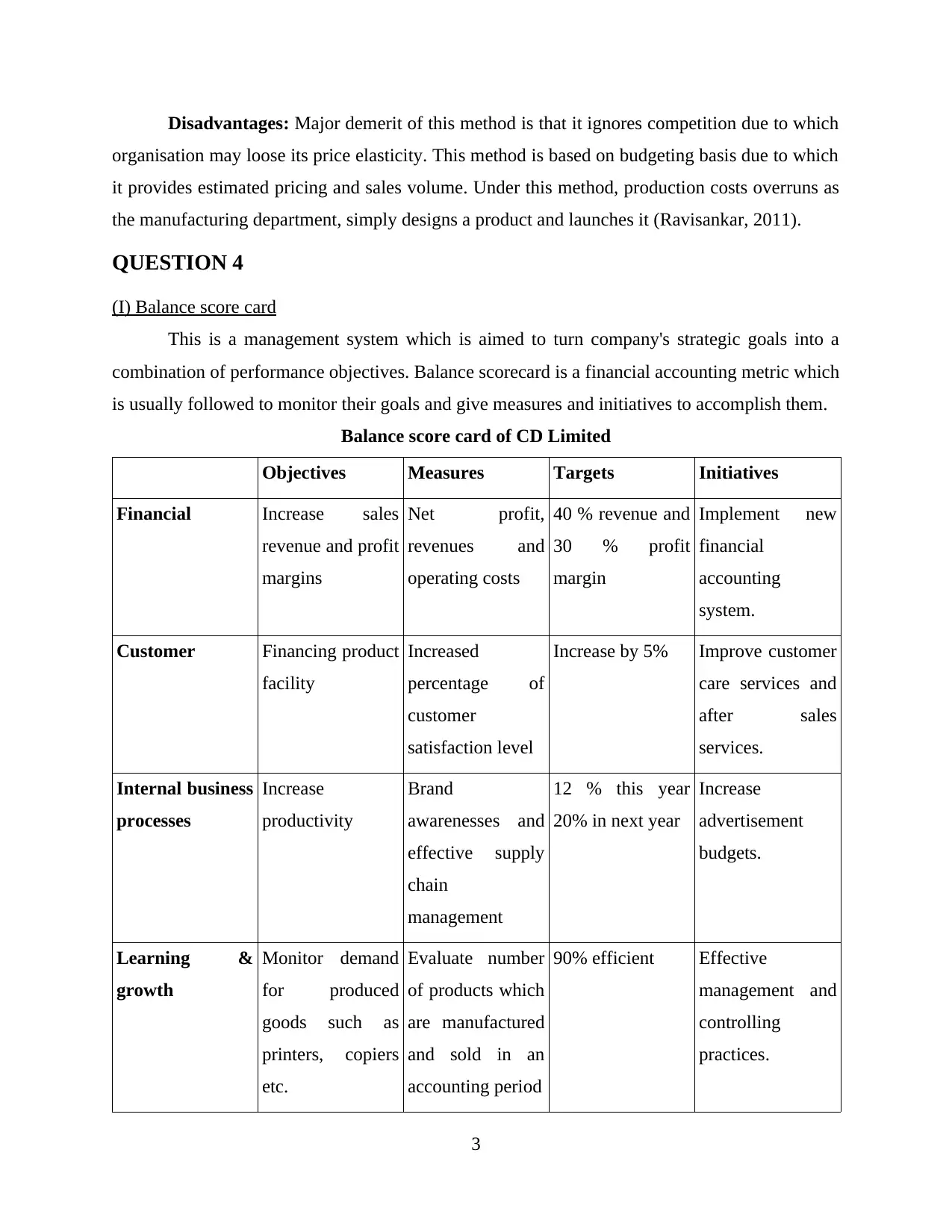
Disadvantages: Major demerit of this method is that it ignores competition due to which
organisation may loose its price elasticity. This method is based on budgeting basis due to which
it provides estimated pricing and sales volume. Under this method, production costs overruns as
the manufacturing department, simply designs a product and launches it (Ravisankar, 2011).
QUESTION 4
(I) Balance score card
This is a management system which is aimed to turn company's strategic goals into a
combination of performance objectives. Balance scorecard is a financial accounting metric which
is usually followed to monitor their goals and give measures and initiatives to accomplish them.
Balance score card of CD Limited
Objectives Measures Targets Initiatives
Financial Increase sales
revenue and profit
margins
Net profit,
revenues and
operating costs
40 % revenue and
30 % profit
margin
Implement new
financial
accounting
system.
Customer Financing product
facility
Increased
percentage of
customer
satisfaction level
Increase by 5% Improve customer
care services and
after sales
services.
Internal business
processes
Increase
productivity
Brand
awarenesses and
effective supply
chain
management
12 % this year
20% in next year
Increase
advertisement
budgets.
Learning &
growth
Monitor demand
for produced
goods such as
printers, copiers
etc.
Evaluate number
of products which
are manufactured
and sold in an
accounting period
90% efficient Effective
management and
controlling
practices.
3
organisation may loose its price elasticity. This method is based on budgeting basis due to which
it provides estimated pricing and sales volume. Under this method, production costs overruns as
the manufacturing department, simply designs a product and launches it (Ravisankar, 2011).
QUESTION 4
(I) Balance score card
This is a management system which is aimed to turn company's strategic goals into a
combination of performance objectives. Balance scorecard is a financial accounting metric which
is usually followed to monitor their goals and give measures and initiatives to accomplish them.
Balance score card of CD Limited
Objectives Measures Targets Initiatives
Financial Increase sales
revenue and profit
margins
Net profit,
revenues and
operating costs
40 % revenue and
30 % profit
margin
Implement new
financial
accounting
system.
Customer Financing product
facility
Increased
percentage of
customer
satisfaction level
Increase by 5% Improve customer
care services and
after sales
services.
Internal business
processes
Increase
productivity
Brand
awarenesses and
effective supply
chain
management
12 % this year
20% in next year
Increase
advertisement
budgets.
Learning &
growth
Monitor demand
for produced
goods such as
printers, copiers
etc.
Evaluate number
of products which
are manufactured
and sold in an
accounting period
90% efficient Effective
management and
controlling
practices.
3
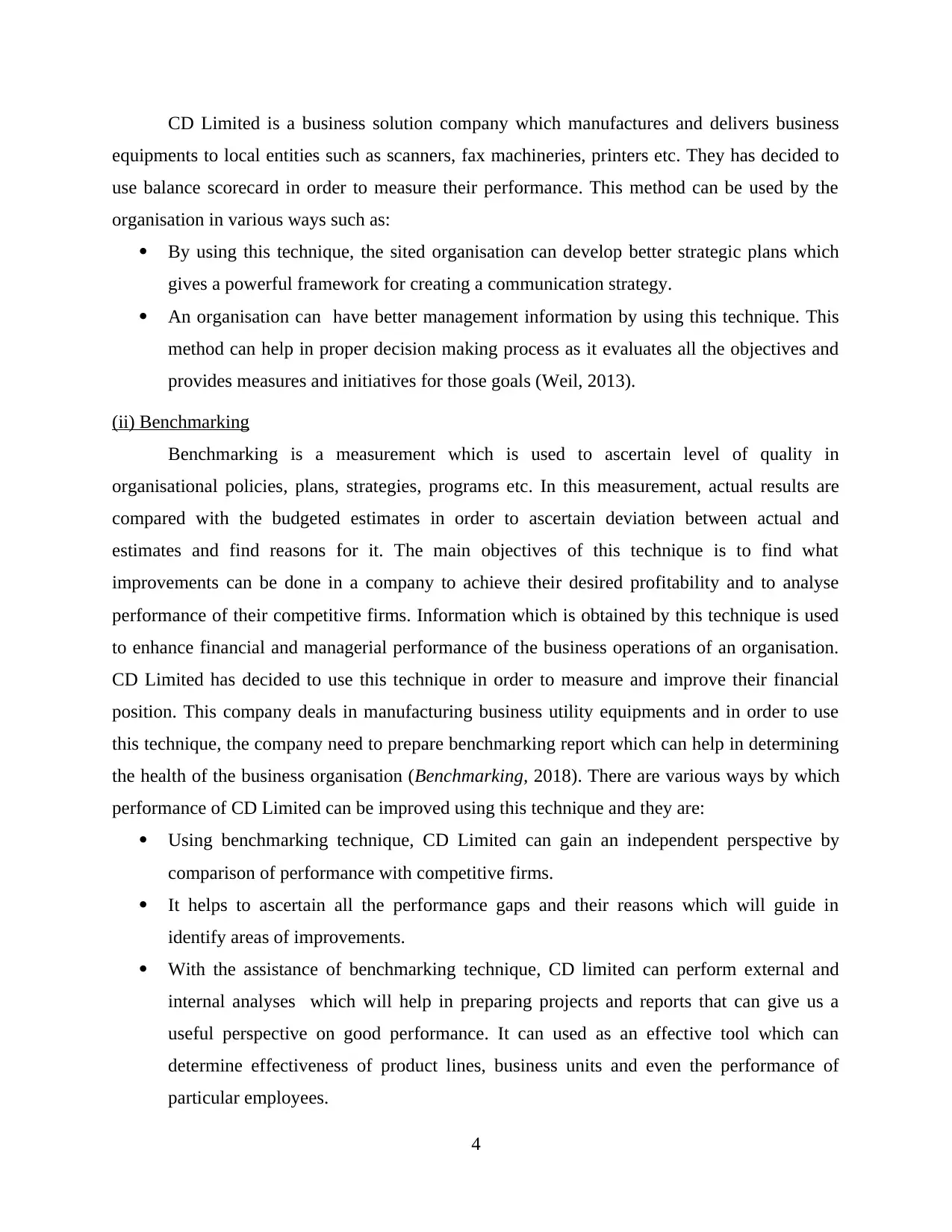
CD Limited is a business solution company which manufactures and delivers business
equipments to local entities such as scanners, fax machineries, printers etc. They has decided to
use balance scorecard in order to measure their performance. This method can be used by the
organisation in various ways such as:
By using this technique, the sited organisation can develop better strategic plans which
gives a powerful framework for creating a communication strategy.
An organisation can have better management information by using this technique. This
method can help in proper decision making process as it evaluates all the objectives and
provides measures and initiatives for those goals (Weil, 2013).
(ii) Benchmarking
Benchmarking is a measurement which is used to ascertain level of quality in
organisational policies, plans, strategies, programs etc. In this measurement, actual results are
compared with the budgeted estimates in order to ascertain deviation between actual and
estimates and find reasons for it. The main objectives of this technique is to find what
improvements can be done in a company to achieve their desired profitability and to analyse
performance of their competitive firms. Information which is obtained by this technique is used
to enhance financial and managerial performance of the business operations of an organisation.
CD Limited has decided to use this technique in order to measure and improve their financial
position. This company deals in manufacturing business utility equipments and in order to use
this technique, the company need to prepare benchmarking report which can help in determining
the health of the business organisation (Benchmarking, 2018). There are various ways by which
performance of CD Limited can be improved using this technique and they are:
Using benchmarking technique, CD Limited can gain an independent perspective by
comparison of performance with competitive firms.
It helps to ascertain all the performance gaps and their reasons which will guide in
identify areas of improvements.
With the assistance of benchmarking technique, CD limited can perform external and
internal analyses which will help in preparing projects and reports that can give us a
useful perspective on good performance. It can used as an effective tool which can
determine effectiveness of product lines, business units and even the performance of
particular employees.
4
equipments to local entities such as scanners, fax machineries, printers etc. They has decided to
use balance scorecard in order to measure their performance. This method can be used by the
organisation in various ways such as:
By using this technique, the sited organisation can develop better strategic plans which
gives a powerful framework for creating a communication strategy.
An organisation can have better management information by using this technique. This
method can help in proper decision making process as it evaluates all the objectives and
provides measures and initiatives for those goals (Weil, 2013).
(ii) Benchmarking
Benchmarking is a measurement which is used to ascertain level of quality in
organisational policies, plans, strategies, programs etc. In this measurement, actual results are
compared with the budgeted estimates in order to ascertain deviation between actual and
estimates and find reasons for it. The main objectives of this technique is to find what
improvements can be done in a company to achieve their desired profitability and to analyse
performance of their competitive firms. Information which is obtained by this technique is used
to enhance financial and managerial performance of the business operations of an organisation.
CD Limited has decided to use this technique in order to measure and improve their financial
position. This company deals in manufacturing business utility equipments and in order to use
this technique, the company need to prepare benchmarking report which can help in determining
the health of the business organisation (Benchmarking, 2018). There are various ways by which
performance of CD Limited can be improved using this technique and they are:
Using benchmarking technique, CD Limited can gain an independent perspective by
comparison of performance with competitive firms.
It helps to ascertain all the performance gaps and their reasons which will guide in
identify areas of improvements.
With the assistance of benchmarking technique, CD limited can perform external and
internal analyses which will help in preparing projects and reports that can give us a
useful perspective on good performance. It can used as an effective tool which can
determine effectiveness of product lines, business units and even the performance of
particular employees.
4
⊘ This is a preview!⊘
Do you want full access?
Subscribe today to unlock all pages.

Trusted by 1+ million students worldwide
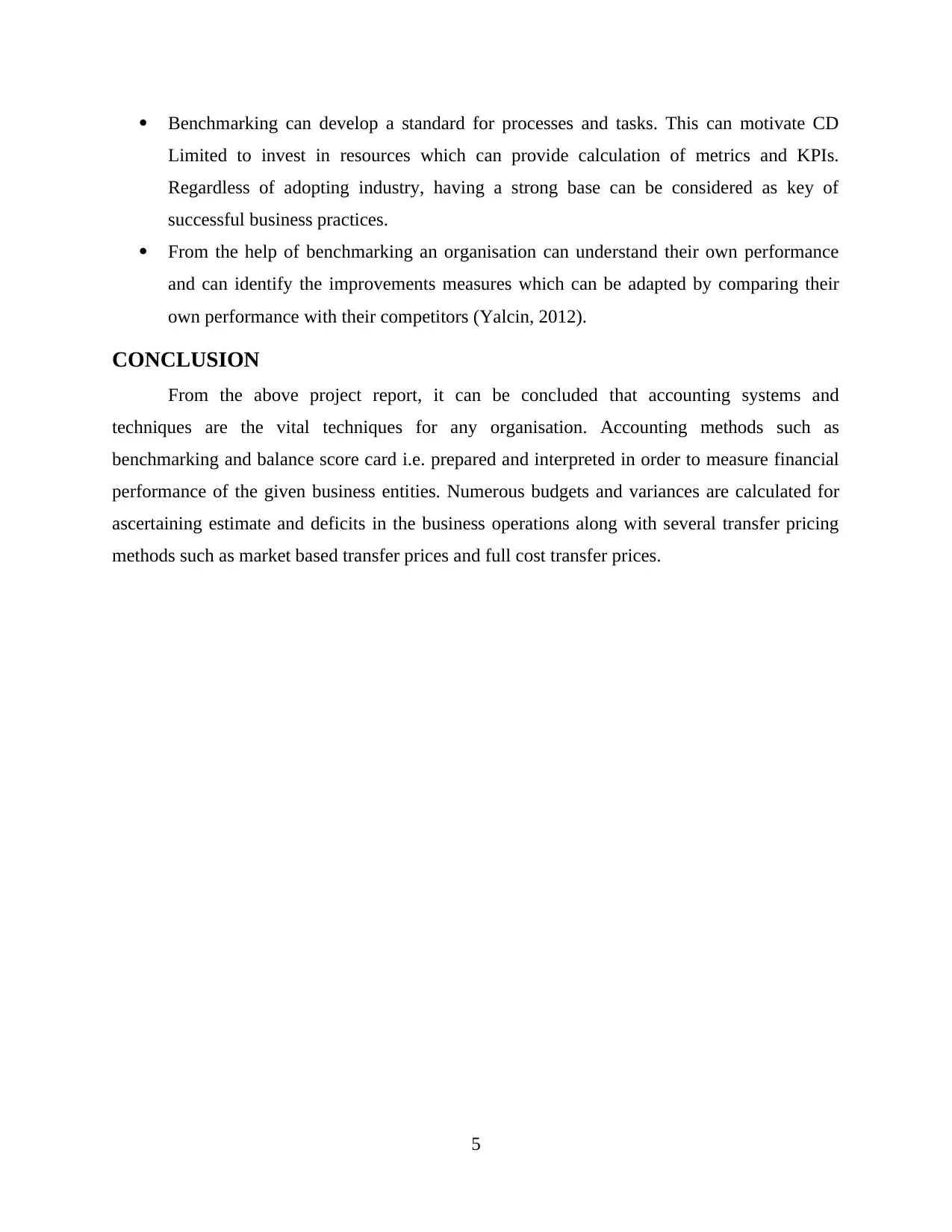
Benchmarking can develop a standard for processes and tasks. This can motivate CD
Limited to invest in resources which can provide calculation of metrics and KPIs.
Regardless of adopting industry, having a strong base can be considered as key of
successful business practices.
From the help of benchmarking an organisation can understand their own performance
and can identify the improvements measures which can be adapted by comparing their
own performance with their competitors (Yalcin, 2012).
CONCLUSION
From the above project report, it can be concluded that accounting systems and
techniques are the vital techniques for any organisation. Accounting methods such as
benchmarking and balance score card i.e. prepared and interpreted in order to measure financial
performance of the given business entities. Numerous budgets and variances are calculated for
ascertaining estimate and deficits in the business operations along with several transfer pricing
methods such as market based transfer prices and full cost transfer prices.
5
Limited to invest in resources which can provide calculation of metrics and KPIs.
Regardless of adopting industry, having a strong base can be considered as key of
successful business practices.
From the help of benchmarking an organisation can understand their own performance
and can identify the improvements measures which can be adapted by comparing their
own performance with their competitors (Yalcin, 2012).
CONCLUSION
From the above project report, it can be concluded that accounting systems and
techniques are the vital techniques for any organisation. Accounting methods such as
benchmarking and balance score card i.e. prepared and interpreted in order to measure financial
performance of the given business entities. Numerous budgets and variances are calculated for
ascertaining estimate and deficits in the business operations along with several transfer pricing
methods such as market based transfer prices and full cost transfer prices.
5
Paraphrase This Document
Need a fresh take? Get an instant paraphrase of this document with our AI Paraphraser
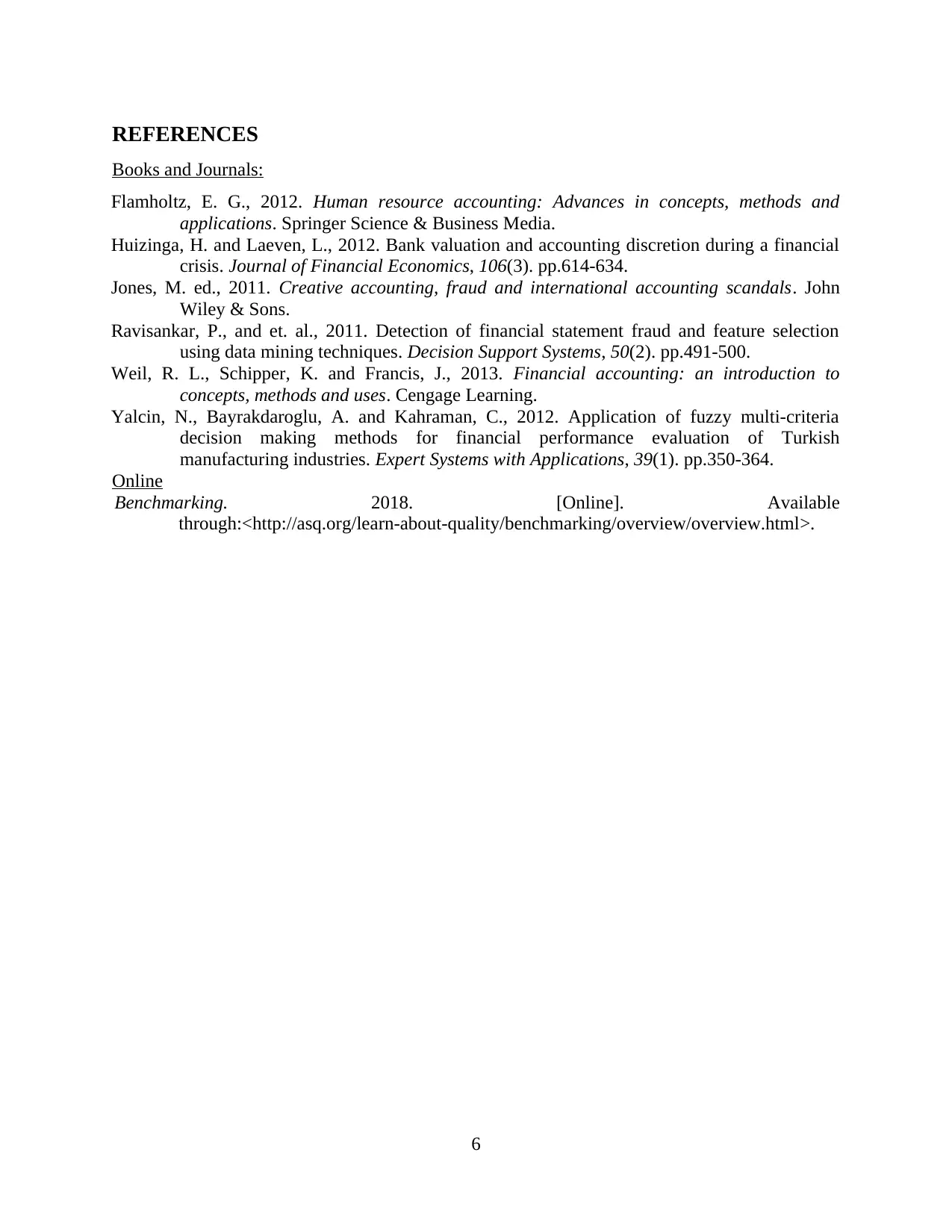
REFERENCES
Books and Journals:
Flamholtz, E. G., 2012. Human resource accounting: Advances in concepts, methods and
applications. Springer Science & Business Media.
Huizinga, H. and Laeven, L., 2012. Bank valuation and accounting discretion during a financial
crisis. Journal of Financial Economics, 106(3). pp.614-634.
Jones, M. ed., 2011. Creative accounting, fraud and international accounting scandals. John
Wiley & Sons.
Ravisankar, P., and et. al., 2011. Detection of financial statement fraud and feature selection
using data mining techniques. Decision Support Systems, 50(2). pp.491-500.
Weil, R. L., Schipper, K. and Francis, J., 2013. Financial accounting: an introduction to
concepts, methods and uses. Cengage Learning.
Yalcin, N., Bayrakdaroglu, A. and Kahraman, C., 2012. Application of fuzzy multi-criteria
decision making methods for financial performance evaluation of Turkish
manufacturing industries. Expert Systems with Applications, 39(1). pp.350-364.
Online
Benchmarking. 2018. [Online]. Available
through:<http://asq.org/learn-about-quality/benchmarking/overview/overview.html>.
6
Books and Journals:
Flamholtz, E. G., 2012. Human resource accounting: Advances in concepts, methods and
applications. Springer Science & Business Media.
Huizinga, H. and Laeven, L., 2012. Bank valuation and accounting discretion during a financial
crisis. Journal of Financial Economics, 106(3). pp.614-634.
Jones, M. ed., 2011. Creative accounting, fraud and international accounting scandals. John
Wiley & Sons.
Ravisankar, P., and et. al., 2011. Detection of financial statement fraud and feature selection
using data mining techniques. Decision Support Systems, 50(2). pp.491-500.
Weil, R. L., Schipper, K. and Francis, J., 2013. Financial accounting: an introduction to
concepts, methods and uses. Cengage Learning.
Yalcin, N., Bayrakdaroglu, A. and Kahraman, C., 2012. Application of fuzzy multi-criteria
decision making methods for financial performance evaluation of Turkish
manufacturing industries. Expert Systems with Applications, 39(1). pp.350-364.
Online
Benchmarking. 2018. [Online]. Available
through:<http://asq.org/learn-about-quality/benchmarking/overview/overview.html>.
6
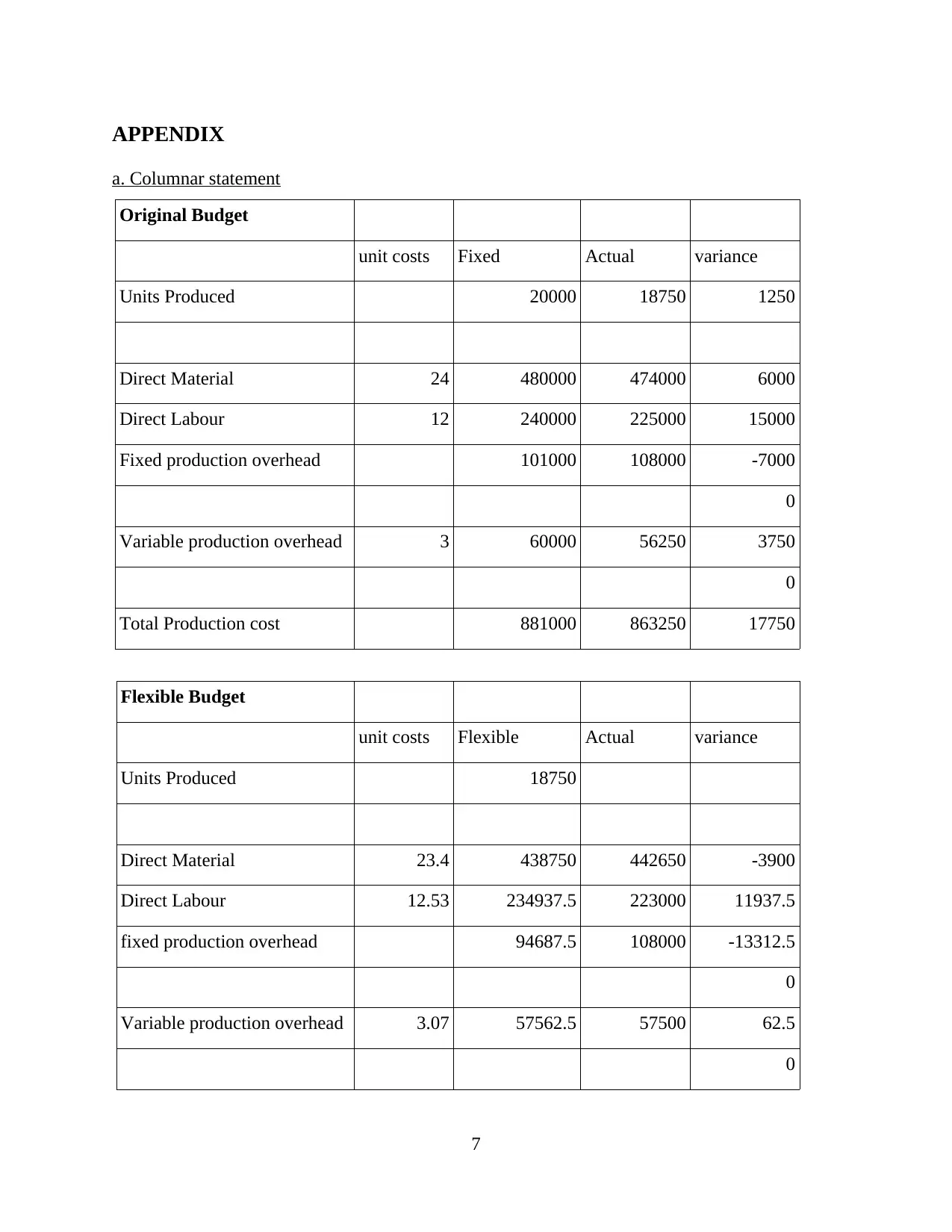
APPENDIX
a. Columnar statement
Original Budget
unit costs Fixed Actual variance
Units Produced 20000 18750 1250
Direct Material 24 480000 474000 6000
Direct Labour 12 240000 225000 15000
Fixed production overhead 101000 108000 -7000
0
Variable production overhead 3 60000 56250 3750
0
Total Production cost 881000 863250 17750
Flexible Budget
unit costs Flexible Actual variance
Units Produced 18750
Direct Material 23.4 438750 442650 -3900
Direct Labour 12.53 234937.5 223000 11937.5
fixed production overhead 94687.5 108000 -13312.5
0
Variable production overhead 3.07 57562.5 57500 62.5
0
7
a. Columnar statement
Original Budget
unit costs Fixed Actual variance
Units Produced 20000 18750 1250
Direct Material 24 480000 474000 6000
Direct Labour 12 240000 225000 15000
Fixed production overhead 101000 108000 -7000
0
Variable production overhead 3 60000 56250 3750
0
Total Production cost 881000 863250 17750
Flexible Budget
unit costs Flexible Actual variance
Units Produced 18750
Direct Material 23.4 438750 442650 -3900
Direct Labour 12.53 234937.5 223000 11937.5
fixed production overhead 94687.5 108000 -13312.5
0
Variable production overhead 3.07 57562.5 57500 62.5
0
7
⊘ This is a preview!⊘
Do you want full access?
Subscribe today to unlock all pages.

Trusted by 1+ million students worldwide
1 out of 9
Related Documents
Your All-in-One AI-Powered Toolkit for Academic Success.
+13062052269
info@desklib.com
Available 24*7 on WhatsApp / Email
![[object Object]](/_next/static/media/star-bottom.7253800d.svg)
Unlock your academic potential
Copyright © 2020–2025 A2Z Services. All Rights Reserved. Developed and managed by ZUCOL.




